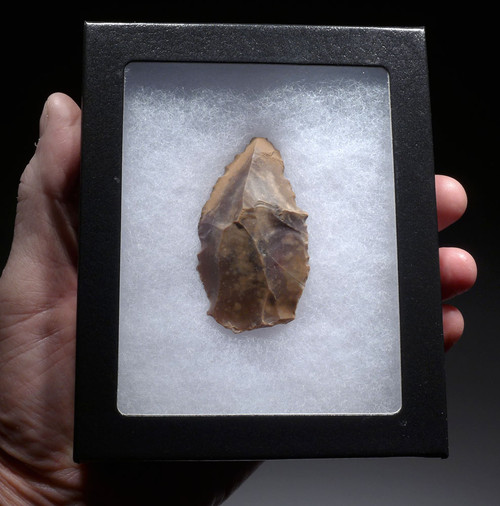Product Description
For comparison prices, please see the "Old World Typology and Price Guide" section of the "OVERSTREET IDENTIFICATION AND PRICE GUIDE TO INDIAN ARROWHEADS" editions 7th, 8th and 9th.
SEE MORE PREHISTORIC MIDDLE STONE AGE TOOLS
This rare and LARGE bifacial stone spearhead projectile point dates to the Middle Stone Age (MSA) of Africa, between 280,000 and 50,000 years ago. It was made of shale which has eroded over the millennia of wind exposure, to reveal the thin layers in the stone, leaving an incredibly aesthetic appearance! It is THE LARGEST bifacial spearhead projectile point we have ever collected from the Middle Stone Age of Africa. It was made by either anatomically modern humans (Homo sapiens), or archaic Homo sapiens. This is an exclusive offering being one of only a few stone tools we acquired from an old Dutch collection. Once sold, we will never have any tools of this type to offer again.
Large prehistoric African game such as giraffe, elephant, camels and hippos would have required a spear tipped with a large stone projectile point such as this, to successfully hunt. A spearhead of this size would have also proven fatal in human warfare.
HISTORY
The Middle Stone Age (or MSA) was a period of African prehistory between the Early Stone Age and the Late Stone Age. It is generally considered to have begun around 280,000 years ago and ended around 50–25,000 years ago. The beginnings of particular MSA stone tools have their origins as far back as 550–500,000 years ago and as such some researchers consider this to be the beginnings of the MSA. The MSA is often mistakenly understood to be synonymous with the Middle Paleolithic of Europe, especially due to their roughly contemporaneous time span, however, the Middle Paleolithic of Europe represents an entirely different hominin population, Homo neanderthalensis, than the MSA of Africa, which did not have Neanderthal populations. Additionally, current archaeological research in Africa has yielded much evidence to suggest that modern human behavior and cognition was beginning to develop much earlier in Africa during the MSA than it was in Europe during the Middle Paleolithic. The MSA is associated with both anatomically modern humans (Homo sapiens) as well as archaic Homo sapiens.
The stone tool technology in use during the Middle Stone Age (MSA) shows a mosaic of techniques. Beginning approximately 300 kya, the large cutting tools of the Achuelian are gradually displaced by Levallois prepared core technologies, also widely used by Neanderthals during the European Middle Paleolithic. As the MSA progresses, highly varied technocomplexes become common throughout Africa and include pointed artifacts, blades, retouched flakes, end and side scrapers, grinding stones, and even bone tools. However, the use of blades (associated mainly with the Upper Paleolithic in Europe) is seen at many sites as well. In Africa, blades may have been used during the transition from the Early Stone Age to the Middle Stone Age onwards. Finally, during the later part of the Middle Stone Age, microlithic technologies aimed at producing replaceable components of composite hafted tools are seen from at least 70 ka at sites such as Pinnacle Point and Diepkloof Rock Shelter in South Africa.
 US DOLLAR
US DOLLAR
 EURO
EURO
 AUSTRALIAN DOLLAR
AUSTRALIAN DOLLAR
 CANADIAN DOLLAR
CANADIAN DOLLAR
 POUND STERLING
POUND STERLING






















